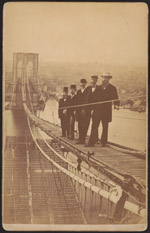Photographic Processes: 1839 – 1889
ALBUMEN PRINT, 1855-1895
Silver-based paper positive with albumen (egg whites) as binder to hold light sensitive materials, usually printed from a collodion negative
Paper is coated with a thin layer of salted albumen, sensitized with a solution of silver nitrate, and dried. The paper is then "printed-out" with the paper in direct and tight contact with the negative, washed, toned in a gold chloride bath and fixed in hypo. They are often mounted on card stock due to the thin paper. Albumen prints are the most common form of 19th-century photograph.
Albumen prints of good condition have brown to purple image tone with white highlights. Vintage albumen prints now appear slightly faded with a yellow tone because albumen yellows and silver oxidizes over time.
 |
Unidentified. Albumen Print, Printed From a Wet Plate Collodion Negative, ca. 1881. [zoom] Cabinet card mount The Brooklyn Bridge, completed in 1883, was one of the greatest engineering feats of the 19th century. This photograph includes Washington Roebling, the project’s chief engineer and the son of John A. Roebling, the bridge’s designer. Within a week of opening, a rumor that the bridge was going to collapse caused a stampede killing twelve people. With characteristic public spiritedness and self-promotion, P. T. Barnum helped restore confidence in the bridge by crossing it with a herd of elephants. On loan from the Stephan and Beth Loewentheil Family Photographic Collection. |